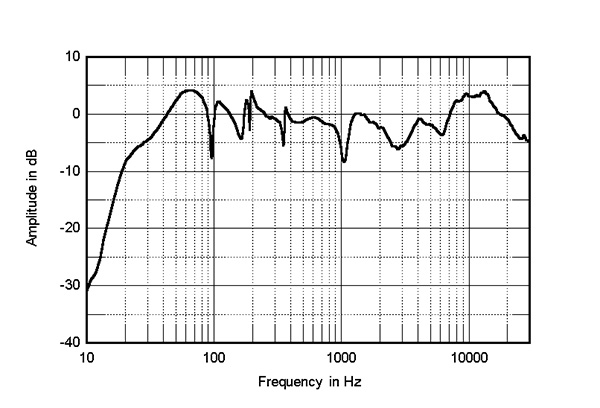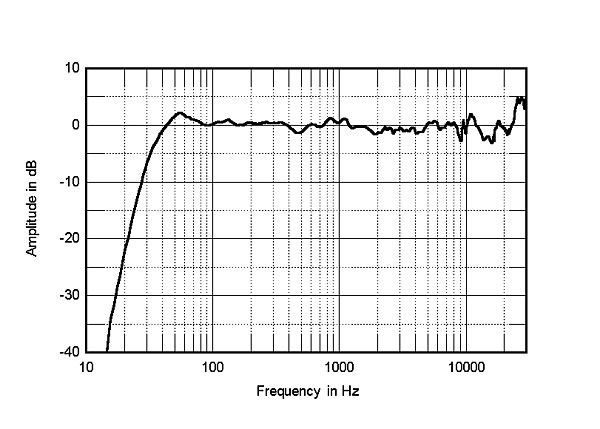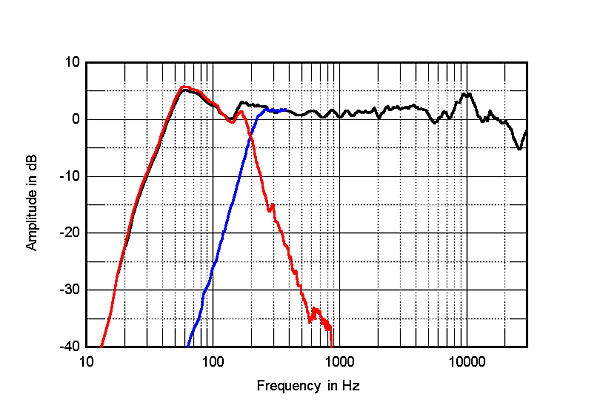This is timely as there have been discussions of specifically the Alta Alyssa here recently. I was curious about the brand having heard good things so have read several reviews and comments from people who’ve heard Alta speakers at shows, and although there are some glowing comments there are also detractors citing things like frequency balance that can obviously be very room dependent and, more concerning, discontinuity between drivers. I’m like you in that I look at measurements and find them useful and helpful, but the final arbiter is always my my ears, but in this particular case I can’t help thinking the measurements are exposing issues that might actually be audible for some listeners. At the very least this would seem to indicate that Alta speakers, even more so than most other speakers, need to be auditioned in person and preferably in one’s own room if at all possible.
What if a high end speaker measures really badly?
You know, it's true that I feel listening is more important than measurements and that it's generally difficult to really tie together measurements with pleasure. Below 0.05% THD do I care? No I do not. I really don't care. The number tells me nothing about whether I'd like the amp more or not anymore.
In this one memorable review for the Alta Audio Adam speaker, I really felt shivers go up my spine when I looked at the measurements, especially at ~$20kUSD. This looks like an absolute hot mess. Does it sound this bad though? I certainly don't have the $20K to test that out myself. What do you all think?

Hmmm, let me take a guess.... He a) bought the drivers from someone else b) threw it in a box in an exotic garage and c) wants to charge 20k for something that measures like this...meh No thanks...I’d probably send this speaker back to its daddy. (In general, put some high caliber electronics on any pig and it could start to sound pleasing at some point. But, the pig is still a pig that’s getting carried.)
If a speaker costs 5k and above, my core requirements are: a) All drivers need to designed/developed in-house from scratch! b) Everything about the speaker should be designed from the ground up! c) Measurements should indicate engineering competence, even if it is not pristine
Here are the measurements close to my 30k speaker (everything developed in-house from scratch by the manufacturer)
Here’s the measurement on my 15k speaker (everything developed in-house from scratch by the manufacturer)
Here’s the measurement on my 5k speaker (everything developed in-house from scratch by the manufacturer)
If it is under 5k, i am forgiving of the drivers coming from someone else. I’ll forgive you!! But, now, it better measure like a pristine cat, because the manufacturer’s doing way less work now!! So, here’s my 3k speaker (~1500 if ya DIY’d the kit) with drivers from someone else.
|
Narrow-band peaks and dips which occur within about 1/3 octave of one another tend to be "averaged" by the ear. Therefore, that on-axis frequency response graph looks far worse to the eyes than it sounds to the ears. The on-axis dip at 3 kHz is wide enough to survive the ear's "averaging" characteristic, BUT it corresponds with an off-axis rise in that region. So my guess is the designer put a dip at the bottom end of the tweeter’s range to compensate for an off-axis "flare". Imo this is a good design choice. The on-axis emphasis centered around 11 kHz can be compensated for by listening off-axis. In fact, it looks to me like at about maybe 10-20 degrees off-axis the 3 kHz dip fills in and the 11 kHz bump smooths out. My guess is that this speaker would sound excellent with proper set-up. Duke Not an Alta Audio dealer |
@soix has it right. The Alta Audio speakers should be listened to before buying. I was one of those commenting on the Alyssa thread about frequency response and discontinuity issues. There were three speakers from them represented at Axpona. I heard the same issue on all of them. After the show, I wanted to see if there were measurements out there showing what I heard. Stereophile measurements of the Adam and Alyssa clearly show issues at around 3k, and to me it is audible. I wanted to like them, because they look beautiful. Some people may like the sound that they produce, I did not. |
Probably not myself personally, but If someone likes the sound of an expensive speaker it does not matter that it does not measure well or technically may be poorly designed or implemented. The off base measurements will probably be an indicator of the particular unique sound that is liked and is less likely to be found elsewhere. In other words a poorly engineered speaker may sound unique and distinguish itself from others but the reason it sounds that way may not be a very good one. Or one may just be drawn to a product by aesthetics. You have to live with your speakers so looks matter. It’s all good even if not so much technically. |
If it measures “really badly,” then it’s not a high end speaker IME. All the absolute best speakers I’ve heard and owned measure exceptionally well. I have zero doubt that these days I would be able to quickly hear the issues with that Alta speaker. A decade ago when I was much less experienced, it’s likely that had I auditioned that same speaker, I would’ve thought it pretty good. |
The Alta Alyssa also seems to be radically oddly designed. In the case of the Adam it's almost as if the designers have deliberately introduced some comb filtering into the frequency response, kind of a hard thing to do if you are paying even moderate attention in crossover theory class. Perhaps the radically different response curves make the speakers sound more detailed and make the reviewer go through their entire album collection again to hear what they've been missing.... 🤢 Sorry, that's a bit of a cliche I read when speakers are deliberately ragged. If the peaks and dips are not audible, as @audiokinesis suggests then I wonder why and how they went through all the trouble to introduce them in the first place? 🤣 |
@erik_squires wrote: "If the peaks and dips are not audible, as @audiokinesis suggests then I wonder why and how they went through all the trouble to introduce them in the first place?" I think the up/down peak/dip jogs are artifacts of the enclosure design, which is apparently a transmission line/port hybrid. There are corresponding little spikes in the impedance curve that look like what I've seen in some of my transmission line builds. |
Fwiw I have kef ls50 meta ( + Klipsch sw308 powered sub), Ohm Walsh and Sonus Faber Concerto Domus each in different rooms. I use Roon DSP to tweak the sound of each in their corresponding rooms. The KEFs are known for their good technical measurements. The Sonus Faber also have measured well but not as well as the KEFs. I have seen measurements of earlier Ohm Walsh models from years ago and they tend to be good but are not as conclusive perhaps due to age. Each room’s acoustics measure much differently and each has its rougher areas that I have tackled via room correction using Roon DSP. These are all “good quality” speakers. Once room is corrected for they start to sound more similar than different in regards to tonality. Soundstage imaging and detail is very good in each case but each is somewhat unique in this regard. So once room is corrected I then use Parametric EQ in Roon DSP to tailor to my taste. The good measuring kefs require the least, just a bit of a bump from 4-6khz to liven things up a tad. The other two may get a similar bump but there are also remaining high end and bass related tweaks I apply to get them sounding just right to me at my listening position. So after all that in the end they each sound quite similar in regards to tone. The kefs are the ones that reveal the most detail in the recordings. The Sonus Faber provide a touch of added “musicality” that I would attribute to their cabinet designed to deliver sound more like an orchestral string instrument. The pseudo-Omnidirectional Ohms are somewhere in between and always excel at delivering a live like sound where the players are in your room as opposed to you being drawn into the recording. So there you have it. Measures serve a purpose to help differentiate gear out of the box and also facilitate getting them tweaked effectively as needed but alone do not assure a clear winner. No surprise there eh? Also I have learned that DSP is the great equalizer. No reason these days to be stuck with the sound you get out of the box. If the speakers are up to the task given the room at hand, almost anything is possible from there with a proper amp and DSP. |
Sometimes, it's the charts/graphs/measured specs that catch the eye and make the ears desire a listen of.... But having to explore and posit what v. why to such a degree makes this mortal consider that make these 'A' series units seem to be 'space finicky'... You wouldn't know if you Really Like them until in Your space with them. At 20K$-ish, one might be tempted to look about at 'other items in place' and enter into the old '...what if it's the....?' hunter/gatherer routine.... No dog in the hunt (and no $ to join in, either), I'd keep shopping. Don't need more complications in a life with enough already.... A 195hz 'dip' due to the enclosures' back panel...Occam's Razor, anyone?
|
I’ll go out on a limb and assert that in the end, proper application of measurements always helps to achieve one’s hifi sound goals faster, more effectively and for less. The trick is to be able to understand and apply the numbers properly and I think that is not easy but a worthwhile goal for any audiophile. More good and reliable data informs better decision making. But the devil is always in the details. Practically though, each will end up finding their own way as best they can. Sometimes it’s the journey that matters more than reaching the final destination.
It’s all good. Cheers! |
@erik_squires - that's a very ragged frequency response graph. I don't think speakers have to measure perfectly to sound good - Wilson Audio speakers are not textbook. But there's a difference between small deviations and big ones. |
@erik_squires I don’t think we can say much of anything about that graph, and the others presented here without knowing the level of smoothing applied to the raw data. As I am sure you know anyone who has played around with Room Equalization Wizard software knows that you can make a washboard look like a pancake with adequate smoothing applied to the chart. It’s frustrating because that critical piece of information is very seldom supplied with charts such as these when published. |
I don’t think the measurements should be ignored completely when buying speakers, even if they sound good to your ears. Over time, and outside the showroom, any serious flaws might start to become apparent. Reviewing the impedance graph can be even more important in terms of matching with your amplifier. Comparing sensitivity and nominal impedance only can result in a mismatch if there are some dips that your amplifier is not equipped to handle. |
@audiokinesis Ahhh! Thank you, I missed that in the article. That explains why they posted the inner design of the 2-way as well. |
A speaker can sound very good yet have a significant dip (or more than one). Generally that dip is at the bottom and most people check for that by playing songs heavy in bass. But a dip at a different frequency might not be caught until you play that one song that has an important note at that frequency and you say "what happened to that chord?" Then you know something is missing and can’t enjoy the speakers any more. I do like to see a graph or a published number. Here are the numbers from my speakers: 20 – 20000 [Hz] ±3 [dB] Looking at the graph for this speaker, it looks like the numbers would be 20-20,000 hz, +4/-8 dB. I think that would raise some eyebrows. Jerry PS Everyone says "listen to these before you buy. My point is you may not catch these dips in a 15 minute audition. |
@bruce19 True, but the problem here is that, if anything, the graph was not smoothed enough! 🤣 Are you suggesting maybe this speaker is far worse than it seems? My point is, we know at least that those deep valleys are not due to over-smoothing. |
In high-end industry crowded by unaware and uneducated rich kids of baby boomers you can take different approaches. 1) Design Measure Build and Measure again then present and advertise 2) Build Present and Advertise -- provide unmeasured good looking parameters. Measuring per specific room is important. That gives a consumer an idea if these speakers will match his/her room.
|
Yes, exactly. With a little experience, and a lot of misspent money/youth you’ll realize how extra-sexy speakers which reveal sounds you’ve never heard before, won’t actually last long in your listening room. Oddly, where these speakers do measure well is in the horizontal dispersion. I’d expect they have an excellent and wide sweet spot, though not a very tall one. |
This is an area where I think Vandersteen does it exactly right. Uses an active woofer with built in EQ and a low pass filter for the amps. In hotel rooms this delivered exceptional bass in a tiny room. |
@deep_333 illustrates the deep, deep chasm between DIY builders and kit makers, modders vs. the high end industry writ large. "How can a speaker maker offer such poor performance for so much money" they ask, and sometimes I have trouble defending some models. |
Be careful @erik_squires. Another Eric may sue you for posting about measurements. Oh, wait, wrong choice of words. He may "litigate"... |
Question: when FR graph such as those above show the db level at, say, 1khz, does the measured response include any other frequencies - such as resonances introduced by the speaker? Also, I assume, the graphs alone do not reflect phase consistency between a fundamental and the harmonics typical in music, or differing decay rates for the fundamental vs harmonics. I believe these factors are critical for imaging and musical realism. |
As you may know, many guys on the diy forums (i have seen your name there as well) can do something better with the same parts than the guy asking 20k for this (facepalm)... This guy trying to make the easy cash did not deserve 20k in my books (no thanks). Every speaker i own above a certain price point is something i can't cook up on my own. It immediately disqualifies manufacturers purchasing 3rd party drivers and throwing them in a box for me. I tend to pay for things i can't do on my own.. Unless if it becomes too much of a time investment/hassle/screwups/etc at a low enough price, it begins to reek "Just buy the damn thing and get it over with!".
|
@erik_squires is that speaker measurement (anechoic chamber) and it's imperfections become mute at nominal listening distances in an average set up room? Therefore does the measurement really matter in choice of purchase, if you liked the sound more than X or Y speaker? Granted, I think there were some solid points made for similar priced speakers that DO have damn near perfect frequency response graphs (assumed anechoic). |
@amtprod I think @audiokinesis was making some of those arguments, that some of these deep valleys may not actually be something most of us would become aware of. No, if you like the sound of speaker Y vs. X buy Y, absolutely. The one caveat is that long term and in room listening matter more than short term auditions. I don't think you can fix the nulls with DSP at all, but mid-treble I think could definitely be cleaned up at least a little. I also don't necessarily think perfectly flat is great, but allow for some discretion in bass bumps, and treble lifts. So, if we squint and really apply major smoothing to the chart these speakers they do seem to be inspired by Fletcher-Munson curves and could be excellent mid-volume speakers. Perhaps that will alleviate the otherwise poor (for a 3-way) sensitivity ratings? |
@amtprod The DSP fixed frequency response and killed the magic. DSP isn't the answer. |
PS - I should point out here that I think we sometimes make the mistake of auditioning speakers at different volumes than we actually listen to at home. If you listen loud, audition loud. Otherwise, spend most of your time listening at the volumes you normally would. Kind of related to this is that a well treated room improves low-volume listening and decreases listening fatigue. |
@erik_squires AND you get time and phase correct, very flat to beyond 25 k and near perfect impulse and of course excellent waterfall ( unless you like cabinet colors…. )…. since 1977…. |
@erik_squires oh you're right, DSP doesn't/can't really fix "nulls" (I guess actual EQ in general isn't great at this to a degree). |
My take: Without prejudice to the fact that I am currently a card-carrying HARBETH disciple with their famous class-leading flat frequency response curve that measures in the top tier ….. and their best of breed midrange …… Just Fuhgeddaboud about all the textbook graphs and like shite, and just refer to your ears and senses in real life experiences. For example: In 1970, JBL released the iconic L100 Loudspeaker. Over the years, the L100 became the bestselling loudspeaker in JBL’s history. These were rock recording studio monitors with a roller-coaster and sine wave frequency response graph …..and everybody loved them. Their easily identified sound, the so-called West Coast sound, was once a highly touted marketing feature. |
I find people that don’t think measurements matter just lack experience. Use REW (it is free!) and start making your own correlations. I have had/have 4 speakers that have full kipple measurements posted publicly. I find frequency response and dispersion to transfer very well from measurements to my room. what I think is still missing in measurements is detail and transient response. The ability of the driver to start and stop with no over hang or over shoot. |
Some bumps are good and others not so much. With DSP, you get to add bumps where needed and where you want them to be, not where they just happened to be when the product shipped. I find with most speakers I tend to like a bump from ~4-6khz. That adds a bit of edge and definition, much like one might expect with a very good pair of high efficiency horns. In particular it helps to keep your attention at lower volumes. The other tweaks I might apply often tend to be more room and listening position dependent.
In the chart in the original post, that relative peak at ~10k in conjunction with the dip just below will likely result in a piercing sound (more fatigue) that might only benefit in certain more extreme cases of hearing loss. Would not be for me most likely. though again it may be nothing that some smartly applied DSP couldn’t resolve. But even if so, better to not have to apply DSP to fix what appears to be a significant design flaw. Better to go with a more suitable design right out of the gate where any bumps perhaps might be better located and maybe even work in your favor in some cases. You decide! To me a good design is always preferrable. |
I'm of two minds about this question. On one hand, I do want my speakers to measure well. It suggests good engineering for one thing. Also, if something is too colored I think it will bother me either immediately or over time. So I always look at measurements. On the other hand: I have really liked some speakers that have been torn to shreds on ASR, e.g. the Devore O series speakers. Devore managed a canny combination of generally neutral on axis sound (O/96) but with some zigs and zaga and I think some resonance. The end result is a speaker with a character that I found utterly engaging, on all types of music. Since I've never owned them I'll never know if my initial audition impressions would hold up, or improve, or if I'd get tired of them over time. I like that my Joseph Audio speakers generally measure well, and are generally well regarded even among the "measurements" crowd. They have a mild "smile" eq, but it is so cannily done it I find it extremely pleasing and seems to give a bit more tonal "life" to the sound. |






